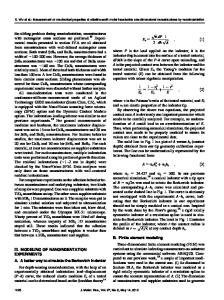Mechanical Properties of Nanostructures
Knowledge of the mechanical properties of nanostructures is necessary for designing realistic MEMS/NEMS devices. Microelectromechanical systems (MEMS) refer to microscopic devices that have a characteristic length of less than 1 mm but more than 1 μm and
- PDF / 1,774,983 Bytes
- 25 Pages / 547.146 x 686 pts Page_size
- 85 Downloads / 421 Views
Knowledge of the mechanical properties of nanostructures is necessary for designing realistic MEMS/NEMS devices. Microelectromechanical systems (MEMS) refer to microscopic devices that have a characteristic length of less than 1 mm but more than 1 µm and combine electrical and mechanical components. Nanoelectromechanical systems (NEMS) refer to nanoscopic devices that have a characteristic length of less than 1 µm and combine electrical and mechanical components. Elastic and inelastic properties are needed to predict deformation from an applied load in the elastic and inelastic regimes, respectively. The strength property is needed to predict the allowable operating limit. Some of the properties of interest are hardness, elastic modulus, bending strength, fracture toughness, and fatigue strength. Structural integrity is of paramount importance in all devices. Load applied during the use of devices can result in component failure. Cracks can develop and propagate under tensile stresses, leading to failure. Atomic force microscopy and nanoindenters can be used satisfactorily to evaluate the mechanical properties of micro/nanoscale structures for use in MEMS/NEMS. The most commonly used materials are single-crystal silicon and silicon-based materials, e.g., SiO2 and polysilicon films deposited by low-pressure chemical vapor deposition. An early study showed silicon to be a mechanically resilient material in addition to its favorable electronic properties. Single-crystal SiC deposited on large-area silicon substrates is used for hightemperature micro/nanosensors and actuators. Amorphous alloys can be formed on both metal and silicon substrates by sputtering and plating techniques, providing more flexibility in surface-integration. Electroless deposited Ni-P amorphous thin films have been used to construct microdevices, especially using the so-called LIGA techniques. Micro/nanodevices need conductors to provide power, as well as electrical/magnetic signals to make them functional. Electroplated
25.1 Experimental Techniques for Measurement of Mechanical Properties of Nanostructures ................. 25.1.1 Indentation and Scratch Tests Using Micro/Nanoindenters ........... 25.1.2 Bending Tests of Nanostructures Using an AFM ..... 25.1.3 Bending Tests Using a Nanoindenter ................... 25.2 Experimental Results and Discussion ...... 25.2.1 Indentation and Scratch Tests of Various Materials Using Micro/Nanoindenters ........... 25.2.2 Bending Tests of Nanobeams Using an AFM ............................... 25.2.3 Bending Tests of Microbeams Using a Nanoindenter ................... 25.3 Finite Element Analysis of Nanostructures with Roughness and Scratches............... 25.3.1 Stress Distribution in a Smooth Nanobeam ................ 25.3.2 Effect of Roughness in the Longitudinal Direction ......... 25.3.3 Effect of Roughness in the Transverse Direction and Scratches .............................. 25.3.4 Effect on Stresses and Displacements for Materials That Are Elastic, Elastic-Plastic, or Elastic-Perfectly Plastic
Data Loading...










